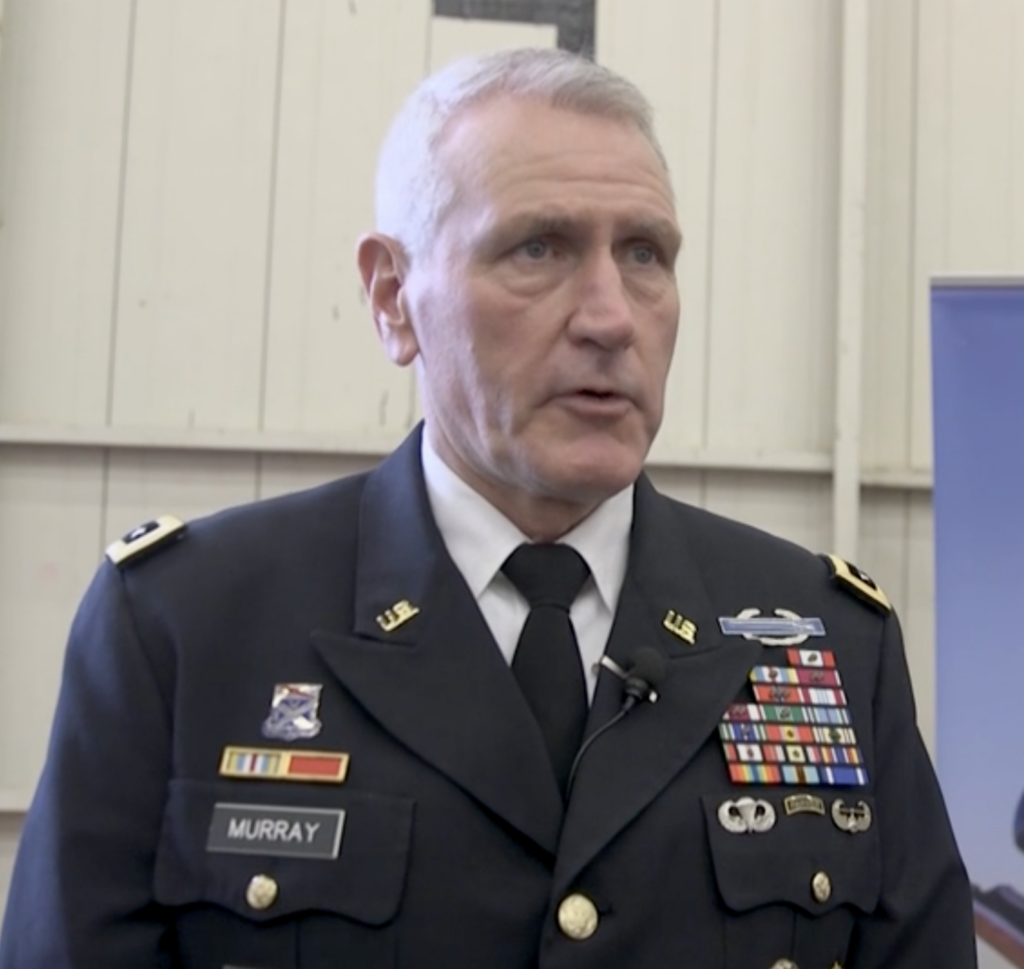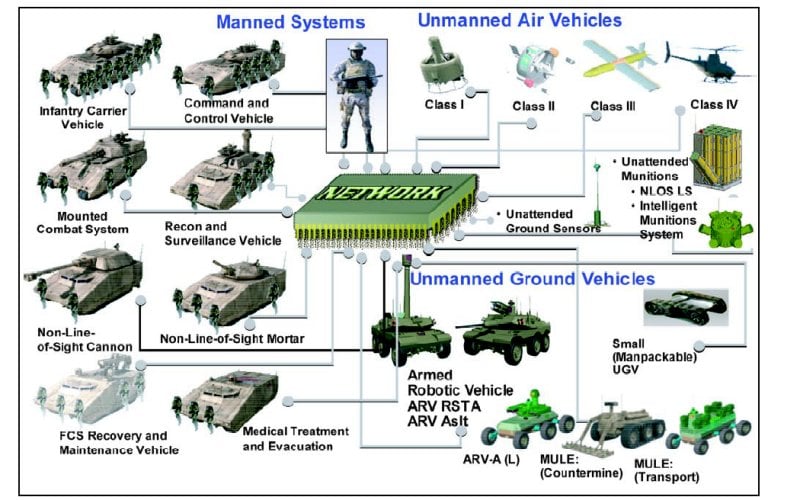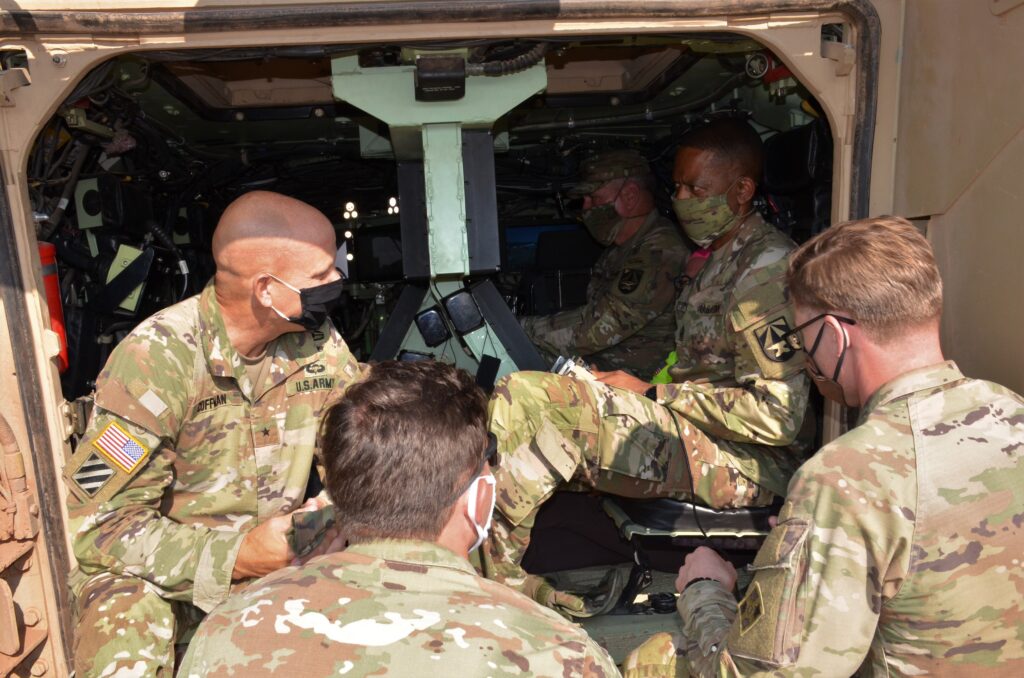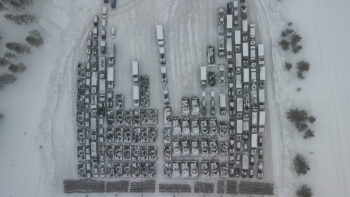
Gen. John Murray
In March, BD’s Sydney Freedberg and Theresa Hitchens sat down for an exclusive hour-long interview with Gen. John “Mike” Murray, chief of Army Futures Command: Click here for Part I, Part II, and Part III. There was so much good material in these interviews that we decided to print this extended excerpt, edited for length and clarity, focusing on the vital issue of Joint All Domain Command and Control.
Q: The Army is talking a lot about speed, range, and convergence, which together lead to decision dominance, which leads to overmatch. Why this new concept? What’s it trying to convey?
A: China is absolutely taking primacy in terms of pacing threats. It’s really an operational defense that we like to call A2/AD or anti-access/area denial, because it’s designed to keep us out. You remember [now-retired Lt. Gen.] Eric Wesley, he used to describe it as a boxer using a jab: So if you’ve got reach, you use the jab to keep your opponent at bay and at a distance.
The idea behind some of the weapon systems we’re developing, some of the formations we’re building, some of the concepts you’re starting to see come out, is, ‘how can we help the joint force penetrate that defense?’ It’s not that you establish domain dominance over the entire area of operations all at once. But how can you take out pieces of it, achieve localized domain dominance that the joint force could exploit?
From a joint perspective, what you want to do is you want to present multiple dilemmas. If you present an opponent just one dilemma, it makes it much easier for them to solve. So, across the five domains, different capabilities coming from different directions, how do you present multiple dilemmas to an enemy?
Q: But are we too focused on finding the things that we can shoot, rather than looking at the enemy as a political animal? And are we too optimistic about being able to find all the things to shoot?
A: It sounds to me like you’re describing what we tried to do in Project Convergence ’20 and to a larger degree, what we’ll do in PC21 in terms of sensor to shooter work. I would argue that is only a very small part of decision dominance.
[It’s] about machine learning, artificial intelligence, eventually quantum computing — the speed at which they’re able to operate, and really the speed at which they’re able to go through data and make logical connections and inferences. [It’s] the ability for a commander to make a good decision, not a perfect decision, faster than their opponent on a future battlefield.
I believe it is going to be an asymmetric advantage. You’ve been around long enough to know the military decision-making process and how long and laborious that can be. You’ve been around long enough to know that commanders are forced to make decisions on imperfect information all the time. And so that’s why I say you’ll never get to the perfect decision. But the ability to make a better decision faster than your opponent is really what I’m talking about in decision dominance.
That could be in a sensor-to-shooter scenario like we demonstrated and will continue to demonstrate [in annual Project Convergence exercises]. That could be, ‘will my opponent go left or right?’ That could be, ‘what are my opponents’ tendencies in terms of their targeting priorities and their operational priorities?’ That could be, ‘what’s going on from a public sentiment standpoint [and] how can I exploit that?’
So I actually see that the decision dominance piece as much bigger than the targeting piece of it.

Army slide showing the elements of the (later canceled) Future Combat System
Q: To a lot of people, this recalls the hubris of the cancelled Future Combat Systems, which promised to “see first, understand first.” How’s that different from “decision dominance”?
A: Sydney, I really do think that there are a lot of differences between the FCS experience and the path we’re on. And I don’t think there is hubris. I think there’s actually humility, and the understanding is that we can’t turn this into the next FCS. We can’t allow this to get big enough that it collapses on its own weight. And we have to stay focused on always stating upfront with the problem we’re trying to solve.
The lessons of FCS, I’ve ingrained in people down here. The ground vehicle would not have survived in Iraq and Afghanistan. But the concept of being able to see and understand, if we’re been pushing on that, I think we would have been in a much better place today. But the whole thing died under its own weight.
And then FCS had this absolute reliance that technology will mature along an Army-specified timeline, which is always a bad bet.
And that’s why I told you we’re in the experimentation mode to understand what technology can and can’t do. I don’t think it will ever be perfect, it just has to be better than our opponents are doing.
Q: So you experiment thoroughly, in labs and in field exercises like Project Convergence, and you bring everything together to see what works and what doesn’t….
A: Yep, and then you write the requirements document. That’s the big difference between what we do with FCS and what you just described. [Once] we understand the technology, we understand the integration challenges, we understand how to make these things work together, so now let’s write the requirements document for what it is we’re going to build.
This is a journey to see what’s possible. What can we do with today’s technologies for a relative minor cost. I’ve described this before, so Project Convergence ’20 cost us about the same thing as one Combat Training Center rotation. And we do, I don’t know, 22 of those a year.
it all started with JADC2 [Joint All-Domain Command & Control], and it all started with the Air Force’s push on ABMS [Advanced Battle Management System] as solving the joint force’s problem. And we had two concerns then; we still have two concerns. One is scale: we’re talking about a different scale when you’re talking ground versus air. [Second], we had a concern about having literally billions of dollars of investment in ground architecture that would never fit into ABMS. And so our discussion with Air Force back then was to allow us to build the ground architecture, no issues with ABMS, and then the joint staff really ought to be focused on how we begin to connect the cloud, to connect architectures, and that really ought to be the standards the joint staff puts in.
And so in December, the Air Force, Navy, Marine Corps, Army, got together and [decided] for Project Convergence 21 the problems we are trying to solve are [five] joint mission threads. The threads are all joint. Everybody’s participating and we hope to continue that.
Q: Do these mission threads come out of the Joint Warfighting Concept and out of the JADC2 strategy?
A: They’re based upon what we call JMETLs, Joint Mission Essential Task lists.
The Joint Warfighting Concept, I just saw a brief on it over the weekend. It’s not to the point yet that we can do that, nor is the JADC2 concept.
I still believe that the best solutions never come from the top down. And so, what we’re trying to do as a joint force, is all four services is inform both of those efforts from the bottom up. So what we’re seeing from technology, what’s possible, and I think we’ll come up with different ways of executing things when we get all four services playing with the technologies we’re all bringing, plus the technologies’ industry will bring.
In the almost 39 years I’ve been around, it’s always amazed me about how soldiers will, number one, figure out a way to make things work and, number two, figure out a way to make things work that I would never have thought of.
We’ve done two industry days. The last one we did was about two weeks ago, that’s 1,300 people on [Microsoft] Teams, listening to our description of the problems we are trying to solve in Project Convergence 21. One of the lessons I think I’ve learned in the two and a half years I’ve been doing this is, start with a problem, don’t start with a solution and allow people to be innovative, whether that’s a small company or a big company, and they can come up with some pretty amazing ideas that I probably wouldn’t come up with.
And so, in this case, all four services coming together from the ground up, working solutions together in actual experimentation, I think will greatly inform and enhance whatever we end up with in terms of, not only a concept, but a system, and really systems of systems, in that overall architecture.

Brig. Gen. Richard Ross Coffman (left) talks to Gen. John “Mike” Murray (right) and Sgt. Maj. Michael Crosby (far right) during a Robotic Combat Vehicle demonstration.
Q: Given that the Air Force’s budget for ABMS has been chopped in half, do you see Project Convergence as taking up that mantle?
A: This may surprise you a little bit: I want to see the Air Force continue with their ABMS work. Because I go back to what I said: I don’t think the Air Force can solve the ground problem and I don’t think I can solve the Air Force problem. So I want to work together to make sure the two are developed in parallel, and not end up with stovepipes at the end that we’ve got to come up with some translation box that makes the two fit together.
It does come down to data. It comes down to data standards and it comes down to architecture. How does the Air Force architecture integrate with the Army architecture and with the Navy architecture? What are those crossover points?
What we’re really asking the joint staff to do is build us the highway. Tell us where the on-ramps are, tell us where the off-ramps are, tell us what the speed limit is, tell how many lanes the highway is going to be, tell us where the roadside rests are going to be. And then allow us to build the vehicles that will operate on that highway — and as long as they’re safe and they can effectively operate on your highway, you shouldn’t worry about the vehicle we are building.
Q: But what about gaps and redundancies? What if everyone builds the same vehicle to do the same then, and your highway has lots of trucks but no passenger cars?
A: I think that was one of the concerns expressed in the NDAA [National Defense Authorization Act], that there’s multiple investments in the same thing. I don’t share that concern because of the different domains that we’re building for [i.e. land, air, sea, space, and cyberspace].
There may be some overlap, and I do think things like increased joint participation in Project Convergence and things like Red Flag will begin to identify some of those overlaps — because, if all the predictions come true, none of us are going to have any money to spare.
Q: So you don’t think there needs to be maybe a specific roles and missions review?
A: I think it’s premature. That’s Murray’s opinion. I know there’s debate.
If predictions are correct and budgets get really tight, we may have to do that, but that I think it’s premature right now. I think there is plenty of room for experimentation as we figure out from a joint force perspective, not only the technology we want to have in the future, but I think it’s fundamentally how we will fight differently, based upon the capabilities we’ll have.






















